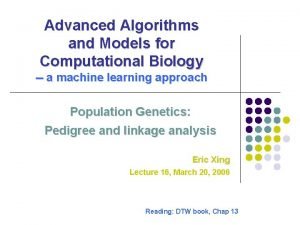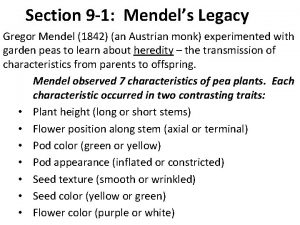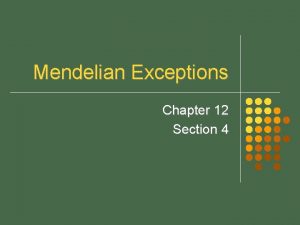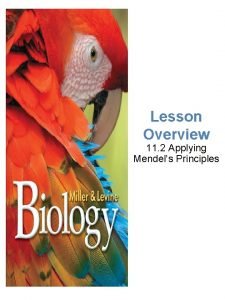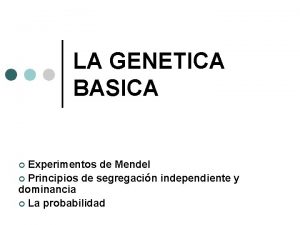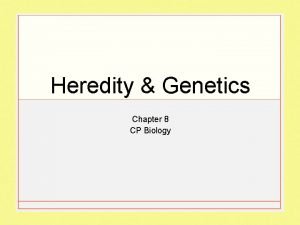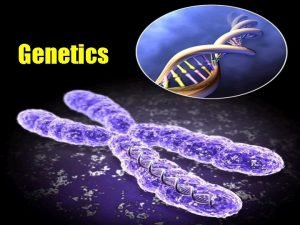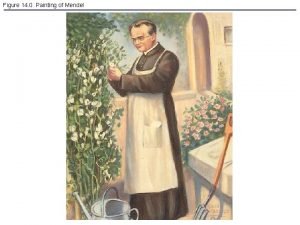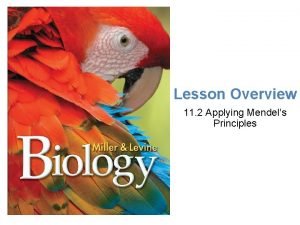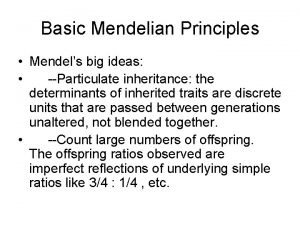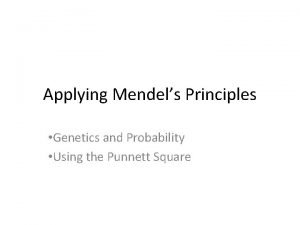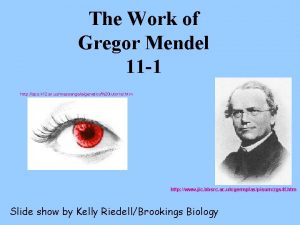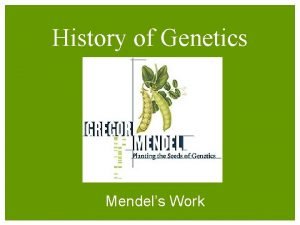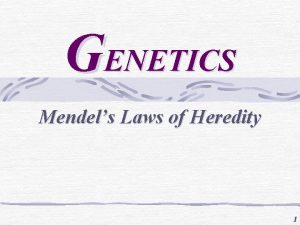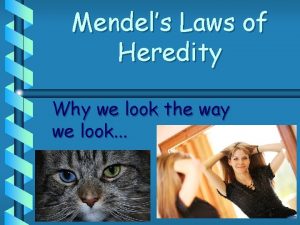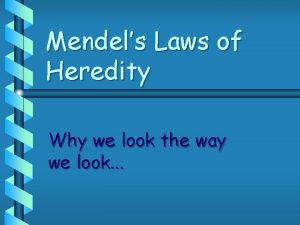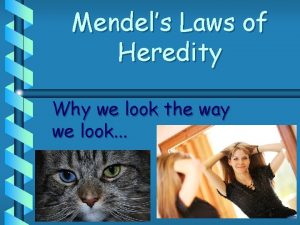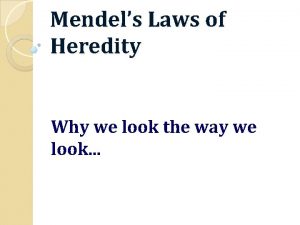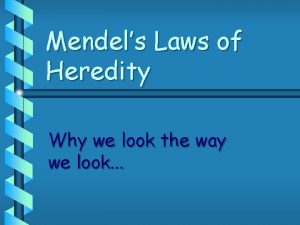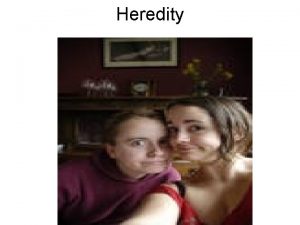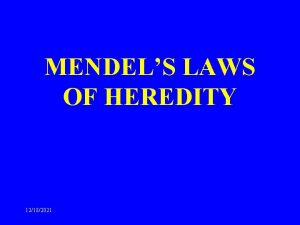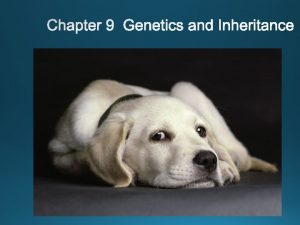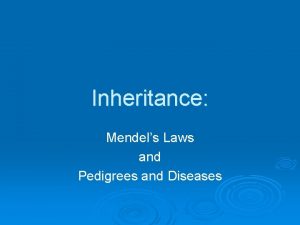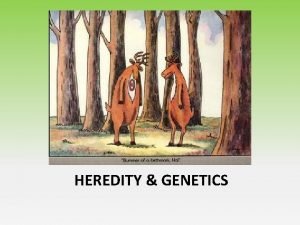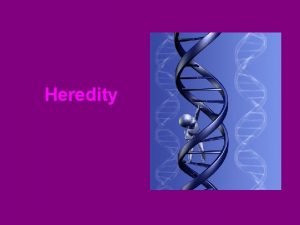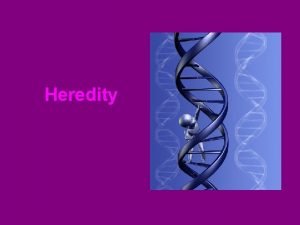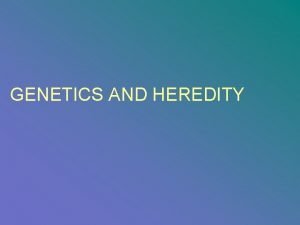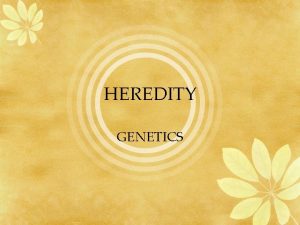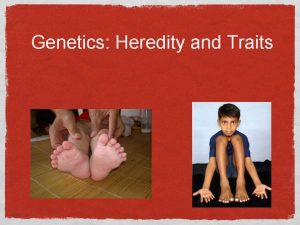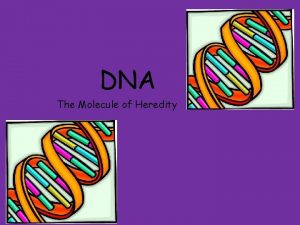Mendels Laws of Heredity Why we look the




























- Slides: 28

Mendel’s Laws of Heredity Why we look the way we look. . .

History Principles of genetics were developed in the mid 19 th century by Gregor Mendel an Austrian Monk. Gregor developed these principles without ANY scientific equipment - only his mind! Gregor experimented with pea plants, by crossing various strains and observing the characteristics of their offspring.

History cont… Studied the following characteristics: üPea color (Green, yellow) üPea shape (round, wrinkled) üFlower color (purple, white) üPlant height (tall, short)

History cont… Made the following observations (example given is pea shape) When he crossed a round pea and wrinkled pea, the offspring (F 1 gen. ) always had round peas. When he crossed these F 1 plants, however, he would get offspring which produced round and wrinkled peas in a 3: 1 ratio.

Genetic Vocabulary Genetics: The scientific study of heredity Genes: Point on a chromosome that controls the trait. Allele: Alternate forms of a gene/factor. A or a Genotype: combination of alleles an organism has. (genetic traits) Phenotype: How an organism appears. (physical traits) Dominant: An allele which is expressed (masks the other). Recessive: An allele which is present but remains unexpressed (masked) Homozygous: Both alleles for a trait are the same. Heterozygous: The organism's alleles for a trait are different.

Genetic Vocabulary Probability : The mathematical chance that an event will happen. Meiosis : The cell division that produces sex cells. Mutation : A change in the type or order of the bases in an organism DNA: deletion, insertion or substitution. Natural Selection : The process by which organisms with favorable traits survive and reproduce at a higher rate than organisms without favorable traits. Evolution : The process by which population accumulate inherited changes over time.

Punnett Squares Genetic problems can be easily solved using a tool called a Punnett square. Tool for calculating genetic probabilities A Punnett square

Punnett Squares Vocabulary Punnett Squares : The chart used to show the possible ways genes are combined when passed from parents to offspring. Dominant genes are UPPER CASE (T) Recessive genes are lower case (t) Each parent has two genes for a trait. (TT), (Tt) or (tt). There can be a possible four combinations for each cross.

Punnett Squares Vocabulary Cont… GENOTYPE: The gene combination Homozygous – Pure dominate or pure recessive Heterozygous – Hybrid a mixed PHEOTYPE : The physical appearance Dominate trait Recessive trait Combination of two traits (incomplete dominance)

INCOMPLETE DOMINANCE : Occurs when two inherited traits combine and show up as a third trait. What is Incomplete Dominance? -- Occurs Incomplete dominance is a type of inheritance in which one allele for a specific trait is not completely dominant over the other allele. This results in a combined phenotype (expressed physical trait). Example, if you cross pollinate red and white snapdragon plants, the dominant allele that produces the red color is not completely dominant over the recessive allele that produces the white color. The resulting offspring are pink.

Monohybrid cross (cross with only 1 trait) Problem: Using this is a several step process, look at the following example Tallness (T) is dominant over shortness (t) in pea plants. A Homozygous tall plant (TT) is crossed with a short plant (tt). What is the genotypic makeup of the offspring? The phenotypic makeup?

Punnett process 1. Determine alleles of each parent, these are given as TT, and tt respectively. 2. Take each possible allele of each parent, separate them, and place each allele either along the top, or along the side of the punnett square.

Punnett process continued Lastly, write the letter for each allele across each column or down each row. The resultant mix is the genotype for the offspring. In this case, each offspring has a Tt (heterozygous tall) genotype, and simply a "Tall" phenotype.

Punnett process continued Here we have some more interesting results: First we now have 3 genotypes (TT, Tt, & tt) in a 1: 2: 1 genotypic ratio. We now have 2 different phenotypes (Tall & short) in a 3: 1 Phenotypic ratio. This is the common outcome from such crosses.

Dihybrid crosses are made when phenotypes and genotypes composed of 2 independent alleles are analyzed. Process is very similar to monohybrid crosses. Example: 2 traits are being analyzed Plant height (Tt) with tall being dominant to short, Flower color (Ww) with Purple flowers being dominant to white.

Dihybrid cross example The cross with a pure-breeding (homozygous) Tall, Purple plant with a pure-breeding Short, white plant should look like this. F 1 generation

You don’t look like…. . Have you ever been told that you resemble one parent more than the other? The reason for this may be due to having received more dominate genes from the parent you resemble. However, you receive half of all your chromosomes and genes from each parent. Each parent passes to you 23 chromosomes for a total of 46 chromosomes.

Lab!” STRATEGY: You will examine ten of your genetic traits. You will examine your parents for these same traits. You can then compare how similar or how different you are to each parent. PROCEDURE: Use the handout that Ms. Olson has given to you to complete the assigned task (lab). Complete the column marked YOU for the genetic traits to be examined. Ask your lab partner to assist you in describing certain traits that you may not be able to see, such as ear lobe shape or hair whorl.

TRAIT DESCRIPTIO N Handedness Left or right YOU FATHER MOTHER

TRAIT DESCRIPTION Sight Nearsighted or normal YOU FATHER MOTHER

TRAIT DESCRIPTIO N Eye color Blue or not Brown eyes Blue eyes YOU Green eyes FATHER MOTHER Hazel eyes

TRAIT DESCRIPTIO N Dimples Yes or No Mario Lopez Josh Holloway YOU FATHER Zinta MOTHER Jada Smith

TRAIT DESCRIPTIO N Freckles Present or Absent YOU FATHER MOTHER

TRAIT DESCRIPTIO N Allergies Yes or No YOU Pollen Animal hair dander FATHER MOTHER Food Medication

TRAIT Hair Whorl DESCRIPTION Clockwise or Counter-clockwise YOU FATHER MOTHER

TRAIT Ear lobe DESCRIPTION YOU FATHER MOTHER Free or Attached Unattached Attached

TRAIT Eye shape DESCRIPTION Close set, Deep set, Hooded, Almond, Down turned, Protruding YOU FATHER MOTHER

TRAIT Tongue DESCRIPTION Roller or Non-roller Rollers YOU FATHER MOTHER
 Look up look down look left look right
Look up look down look left look right Mendels two laws
Mendels two laws Mendels laws
Mendels laws Mendel's experimental design
Mendel's experimental design Hey hey bye bye
Hey hey bye bye Useless laws weaken the necessary laws
Useless laws weaken the necessary laws 9-1 mendels legacy
9-1 mendels legacy Gregor mendels work
Gregor mendels work Chapter 12 lesson 2 applying mendels principles
Chapter 12 lesson 2 applying mendels principles 11.2 applying mendel's principles
11.2 applying mendel's principles Experimentos de mendel
Experimentos de mendel What is codominance in biology
What is codominance in biology Law of independent assortment vs law of segregation
Law of independent assortment vs law of segregation Mendels law of segregation states that
Mendels law of segregation states that For the pedigree in figure 14-6
For the pedigree in figure 14-6 Chapter 12 lesson 2 applying mendels principles
Chapter 12 lesson 2 applying mendels principles Mendel's first law
Mendel's first law Chapter 12 lesson 2 applying mendels principles
Chapter 12 lesson 2 applying mendels principles Mendels fabric
Mendels fabric Applying mendels principles
Applying mendels principles Applying mendels principles
Applying mendels principles Mendels sps
Mendels sps Gregor mendel mbti
Gregor mendel mbti In the punnett square shown in figure 11-1
In the punnett square shown in figure 11-1 Mendel
Mendel Mendels
Mendels Dont ask
Dont ask Look at the picture in activity 3
Look at the picture in activity 3 Activity 1 look at the picture and complete the sentences
Activity 1 look at the picture and complete the sentences

